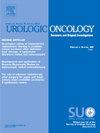Tumor profiling of advanced urothelial carcinoma: Comparative analysis based on social determinants of health
IF 2.3
3区 医学
Q3 ONCOLOGY
Urologic Oncology-seminars and Original Investigations
Pub Date : 2025-07-08
DOI:10.1016/j.urolonc.2025.06.008
引用次数: 0
Abstract
Background
Studies on the genomic characteristics of urothelial carcinoma (UC) patients from diverse backgrounds are scarce. Herein, we sought to characterize genomic landscapes of advanced UC in a regional representative cohort to examine the possibility that patients from different backgrounds may have socioeconomic-influenced molecular changes.
Methods
We retrospectively evaluated clinical and genomic findings of UC patients presenting to the University of Arizona Cancer Center (Tucson, AZ) from 2016 to 2023. Molecular profiles were obtained using DNA next-generation sequencing (Caris Life Sciences) and stratified based on Area Deprivation Index (ADI) collected from each patient residential address. Patients were categorized as living in low (1–49) or high (50–100) ADI residences, with increasing scores indicating higher socioeconomic disadvantage.
Results
Among 97 patients, 43 resided in low ADI areas and 54 in high ADI areas. Higher Hispanic ethnicity (P = 0.011) and lower mean household income (P < 0.001) were seen in high ADI areas. There were no differences in microsatellite instability, loss of heterozygosity or PD-L1 expression. Patients from high ADI neighborhoods had lower TMB scores (62.7 % vs. 51.3%) when compared to low ADI neighborhoods (P = 0.291). The genes with higher rates of alterations when comparing low vs high ADI areas were PIK3CA (20.9% vs. 16.7%, P = 0.610), TP53 (62.8% vs. 40.7%, P = 0.041), KDM (18.6% vs. 22.2%, P = 0.802), ARID1A (20.9% vs. 25.9%, P = 0.636), and TERT (41.9% vs. 35.2%, P = 0.674). A high rate of immunotherapy use (66.7%) and clinic trial enrollment (73.3%) was noted in high ADI patients. There were no overall survival differences between the groups.
Conclusion
Few genomic differences were seen based on socioeconomic status. Lower rates of TP53 alterations and low TMB were seen in patients from disadvantaged neighborhoods. Neighborhood-level factors potentially leading to cancer disparities warrant investigation.
晚期尿路上皮癌的肿瘤特征分析:基于健康社会决定因素的比较分析。
背景:关于不同背景的尿路上皮癌(UC)患者基因组特征的研究很少。在此,我们试图在一个具有区域代表性的队列中表征晚期UC的基因组景观,以研究来自不同背景的患者可能具有社会经济影响的分子变化的可能性。方法:我们回顾性评估2016年至2023年在亚利桑那大学癌症中心(Tucson, AZ)就诊的UC患者的临床和基因组结果。采用新一代DNA测序(Caris Life Sciences)获得分子图谱,并根据从每个患者居住地址收集的区域剥夺指数(Area Deprivation Index, ADI)进行分层。患者被分为生活在低(1-49)或高(50-100)ADI住宅,分数越高表明社会经济劣势越大。结果:97例患者中,低ADI区43例,高ADI区54例。较高的西班牙裔(P = 0.011)和较低的平均家庭收入(P < 0.001)出现在高ADI地区。微卫星不稳定性、杂合性缺失或PD-L1表达没有差异。与低ADI社区相比,来自高ADI社区的患者TMB评分较低(62.7%对51.3%)(P = 0.291)。当比较低和高ADI区域时,具有较高改变率的基因是PIK3CA(20.9%比16.7%,P = 0.610)、TP53(62.8%比40.7%,P = 0.041)、KDM(18.6%比22.2%,P = 0.802)、ARID1A(20.9%比25.9%,P = 0.636)和TERT(41.9%比35.2%,P = 0.674)。在高ADI患者中,免疫治疗使用率(66.7%)和临床试验入组率(73.3%)较高。两组之间总体存活率没有差异。结论:基于社会经济地位的基因组差异不大。来自弱势社区的患者TP53改变和TMB发生率较低。可能导致癌症差异的邻里因素值得调查。
本文章由计算机程序翻译,如有差异,请以英文原文为准。
求助全文
约1分钟内获得全文
求助全文
来源期刊
CiteScore
4.80
自引率
3.70%
发文量
297
审稿时长
7.6 weeks
期刊介绍:
Urologic Oncology: Seminars and Original Investigations is the official journal of the Society of Urologic Oncology. The journal publishes practical, timely, and relevant clinical and basic science research articles which address any aspect of urologic oncology. Each issue comprises original research, news and topics, survey articles providing short commentaries on other important articles in the urologic oncology literature, and reviews including an in-depth Seminar examining a specific clinical dilemma. The journal periodically publishes supplement issues devoted to areas of current interest to the urologic oncology community. Articles published are of interest to researchers and the clinicians involved in the practice of urologic oncology including urologists, oncologists, and radiologists.

 求助内容:
求助内容: 应助结果提醒方式:
应助结果提醒方式:


